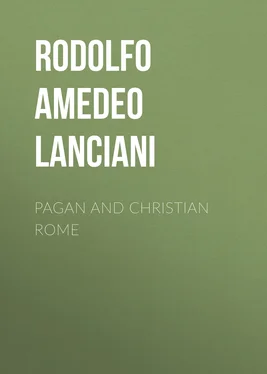Rodolfo Amedeo Lanciani - Pagan and Christian Rome
Здесь есть возможность читать онлайн «Rodolfo Amedeo Lanciani - Pagan and Christian Rome» — ознакомительный отрывок электронной книги совершенно бесплатно, а после прочтения отрывка купить полную версию. В некоторых случаях можно слушать аудио, скачать через торрент в формате fb2 и присутствует краткое содержание. Жанр: foreign_edu, История, История, на английском языке. Описание произведения, (предисловие) а так же отзывы посетителей доступны на портале библиотеки ЛибКат.
- Название:Pagan and Christian Rome
- Автор:
- Жанр:
- Год:неизвестен
- ISBN:нет данных
- Рейтинг книги:3 / 5. Голосов: 1
-
Избранное:Добавить в избранное
- Отзывы:
-
Ваша оценка:
- 60
- 1
- 2
- 3
- 4
- 5
Pagan and Christian Rome: краткое содержание, описание и аннотация
Предлагаем к чтению аннотацию, описание, краткое содержание или предисловие (зависит от того, что написал сам автор книги «Pagan and Christian Rome»). Если вы не нашли необходимую информацию о книге — напишите в комментариях, мы постараемся отыскать её.
Pagan and Christian Rome — читать онлайн ознакомительный отрывок
Ниже представлен текст книги, разбитый по страницам. Система сохранения места последней прочитанной страницы, позволяет с удобством читать онлайн бесплатно книгу «Pagan and Christian Rome», без необходимости каждый раз заново искать на чём Вы остановились. Поставьте закладку, и сможете в любой момент перейти на страницу, на которой закончили чтение.
Интервал:
Закладка:
Many facts related by contemporary documents prove that the change of religion was, at the beginning, a personal affair with the emperor, and not a question of state; the emperor was a Christian, but the old rules of the empire were not interfered with. In dealing with his pagan subjects Constantine showed so much tact and impartiality as to cast doubts upon the sincerity of his conversion. He has been accused of having accepted from the people of Hispellum (Spello, in Umbria), the honor of a temple, and from the inhabitants of Roman Africa that of a priesthood for the worship of his own family ( sacerdotium Flaviæ gentis ). The exculpation is given by Constantine himself in his address of thanks to the Hispellates: "We are pleased and grateful for your determination to raise a temple in honor of our family and of ourselves; and we accept it, provided you do not contaminate it with superstitious practices." The honor of a temple and of a priesthood, therefore, was offered and accepted as a political demonstration, as an act of loyalty, and as an occasion for public festivities, both inaugural and anniversary.
Picture of Orpheus found in the Catacombs of Priscilla.
In accepting rites and customs which were not offensive to her principles and morality, the Church showed equal tact and foresight, and contributed to the peaceful accomplishment of the transformation. These rites and customs, borrowed from classical times, are nowhere so conspicuous as in Rome. Giovanni Marangoni, a scholar of the last century, wrote a book on this subject which is full of valuable information. 16 16 See Bibliography, p. 1. The title of the book may be translated thus: On the pagan and profane objects transferred to churches for their use and adornment .
The subject is so comprehensive, and in a certain sense so well known, that I must satisfy myself by mentioning only a few particulars connected with recent discoveries. First, as to symbolic images allowed in churches and cemeteries. Of Orpheus playing on the lyre, while watching his flock, as a substitute for the Good Shepherd, there have been found in the catacombs four paintings, two reliefs on sarcophagi, one engraving on a gem. Here is the latest representation discovered, from the Catacombs of Priscilla (1888).
The Four Seasons, from the Imperial Palace, Ostia.
The belief that the sibyls had prophesied the advent of Christ made their images popular. The church of the Aracœli is particularly associated with them, because tradition refers the origin of its name to an altar—ARA PRIMOGENITI DEI—raised to the son of God by the emperor Augustus, who had been warned of his advent by the sibylline books. For this reason the figures of Augustus and of the Tiburtine sibyl are painted on either side of the arch above the high altar. They have actually been given the place of honor in this church; and formerly, when at Christmas time the Presepio was exhibited in the second chapel on the left, they occupied the front row, the sibyl pointing out to Augustus the Virgin and the Bambino who appeared in the sky in a halo of light. The two figures, carved in wood, have now disappeared; they were given away or sold thirty years ago, when a new set of images was offered to the Presepio by prince Alexander Torlonia. Prophets and sibyls appear also in Renaissance monuments; they were modelled by della Porta in the Santa Casa at Loretto, painted by Michelangelo in the Sistine chapel, by Raphael in S. Maria della Pace, by Pinturicchio in the Borgia apartments, engraved by Baccio Baldini, a contemporary of Sandro Botticelli, and "graffite" by Matteo di Giovanni in the pavement of the Duomo at Siena.
The images of the Four Seasons are not uncommon on Christian sarcophagi. The latest addition to this class of subjects is to be found in the church of S. Paolo alle Tre Fontane. Four medallions of polychrome mosaic, representing the Hiems , Ver , Æstas , and Autumnus , discovered in the so-called imperial palace at Ostia, were inserted in the pavement of this church by order of Pius IX. Galenus and Hippokrates, manipulating medicines and cordials, were painted in the lower basilica at Anagni, Hermes Trismegistos was represented in mosaic in the Duomo of Siena, the labors of Hercules were carved in ivory in the cathedra of S. Peter's. Montfaucon describes the tomb of the poet Sannazzaro in the church of the Olivetans, Naples, as ornamented with the statues of Apollo and Minerva, and with groups of satyrs. In the eighteenth century the ecclesiastical authorities tried to give a less profane aspect to the composition, by engraving the name of David under the Apollo, and of Judith under the Minerva. Another mixture of sacred and profane conceptions is to be found in the names of some of our Roman churches,—as S. Maria in Minerva, S. Stefano del Cacco (Kynokephalos), S. Lorenzo in Matuta, S. Salvatore in Tellure, all conspicuous landmarks in the history of the transformation of Rome.
I shall mention one more instance. The portrait bust of S. Paul, of silver gilt, from the chapel of the Sancta Sanctorum, was loaded with gems and intaglios of Greek or Græco-Roman workmanship, among which was a magnificent cameo with the portrait-head of Nero, which had been worn, most probably, by the very murderer of the apostle. 17 17 The two busts of S. Peter and S. Paul, described in Cancellieri's book, Memorie storiche delle sacre teste dei santi apostoli Pietro e Paolo , Roma, Ferretti, 1852 (second edition), were stolen by the French revolutionists in 1799.

Ancient Candelabrum in the church of SS. Nereo ed Achilleo.
In the next chapter I shall speak of ancient temples as museums of statuary, galleries of pictures, and cabinets of precious objects. I need not describe the acceptance and development of this tradition by the Church. To it we are indebted for the inexhaustible wealth in works of art of every kind, of which Italy is so proud. But in the period which elapsed between the fall of the empire and the foundation of the Cosmati school, the Christians were compelled, by the want of contemporary productions, to borrow works of art and decorative fragments from temples, palaces, and tombs. The gallery of the Candelabra, in the Vatican museum, has been formed mostly of specimens formerly set up in churches. The accompanying cut represents the candelabrum still existing in the church of SS. Nereo ed Achilleo, one of the most exquisite and delicate works of the kind. The Biga, or two-horse chariot, in the Vatican, was used for centuries as an episcopal throne in the choir of S. Mark's. In the church of the Aracœli there was an altar dedicated to Isis by some one who had returned safely from a perilous journey. This bore the conventional emblem of two footprints, which were believed by the Christians to be the footprints of the angel seen by Gregory the Great on the summit of Hadrian's tomb. Philip de Winghe describes them as those of a puer quinquennis , a boy five years old. 18 18 See Corpus Inscriptionum Latinarum , part VI., No. 351.
This curious relic has been removed to the Capitoline Museum.
The indifference with which these profane and sometimes offensive works were admitted within sacred edifices is astonishing. The high altar in the church of S. Teodoro was supported, until 1703, by a round ara , on the rim of which the following words are now engraved: "On this marble of the gentiles incense was offered to the gods." Another altar, in the church of S. Michele in Borgo, was covered with bas-reliefs and legends belonging to the superstition of Cybele and Atys; a third, in the church of the Aracœli, had been dedicated to the goddess Annona by an importer of wheat. The pavement of the basilica of S. Paul was patched with nine hundred and thirty-one miscellaneous inscriptions; and so were those of S. Martino ai Monti, S. Maria in Trastevere, SS. Giovanni e Paolo, etc. We have one specimen left of these inscribed pavements in the church of SS. Quattro Coronati on the Cælian, which may be called an epigraphic museum.
Читать дальшеИнтервал:
Закладка:
Похожие книги на «Pagan and Christian Rome»
Представляем Вашему вниманию похожие книги на «Pagan and Christian Rome» списком для выбора. Мы отобрали схожую по названию и смыслу литературу в надежде предоставить читателям больше вариантов отыскать новые, интересные, ещё непрочитанные произведения.
Обсуждение, отзывы о книге «Pagan and Christian Rome» и просто собственные мнения читателей. Оставьте ваши комментарии, напишите, что Вы думаете о произведении, его смысле или главных героях. Укажите что конкретно понравилось, а что нет, и почему Вы так считаете.












